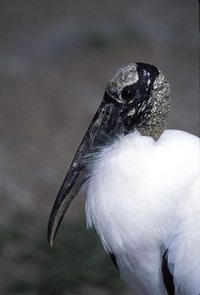Wood Stork
|
|
| Wood Stork | ||||||||||||||
|---|---|---|---|---|---|---|---|---|---|---|---|---|---|---|
 | ||||||||||||||
| Scientific classification | ||||||||||||||
| ||||||||||||||
| Binomial name | ||||||||||||||
| Mycteria americana Linnaeus, 1758 |
The Wood Stork (Mycteria americana) is a large wading bird in the stork family Ciconiidae. It is a tropical species which breeds in much of South America, Central America and the Caribbean. There is a small and endangered breeding population in southern Florida, USA. The Wood Stork is the only stork that breeds in North America.
It is a resident breeder in lowland wetlands with trees. The large stick nest is built in a forest tree. They brood once a year, and 3-5 eggs are laid in the typical clutch. The eggs are incubated 27-32 days by both sexes. Their reproductive cycle is triggered when waterholes dry up sufficiently to concentrate fish in sufficient numbers for efficient feeding of the chicks.
The Wood Stork is a broad-winged soaring bird that flies with its neck outstretched and legs extended.
The adult is a large bird, typically 1m tall with a 1.5 m wingspan. It appears all white on the ground, with blackish-gray legs and pink feet. In flight, the trailing edge of the wings is black. The head is dark brown with a bald, black face, and the thick downcurved bill is dusky yellow. Juvenile birds are a duller version of the adult, generally browner on the neck, and with a paler bill.
The Wood Stork walks slowly and steadily in shallow water up to its belly in open wetlands seeking its prey, which, like that of most of its relatives, consists of fish, frogs and large insects.
References
- Alsop, Fred J. III; Birds of Texas. Smithsonian Handbooks: DK Publishing, Inc., New York (2002).

